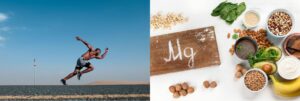
CoQ10 and fertility: myths vs. facts
In recent years, coenzyme Q10 (CoQ10) has become a popular nutrient for couples struggling with fertility. If you work with a fertility specialist, you may

The presence of plastics, especially microplastics, in the environment has attracted increasing attention in recent years. Microplastics are plastic particles that are smaller than 5 mm and often contain a number of toxic chemicals. These are not new pollutants, but only recently have we begun to understand the extent of the problem. They enter the environment either directly, e.g. via toiletries or cleaning products, or indirectly via the decay of larger plastic products, of which around 300 million tons are produced worldwide.
About 80% of microplastics in the marine environment come from land-based activities. An unexpected source is products such as face and body washes, cosmetics and detergents that contain plastic microspheres. Add to that the fact that washing a single garment made of synthetic fabric can release about two thousand plastic fibers per wash cycle, and it becomes clear how important consumer choices are in the home. This microplastic is carried from households to our wastewater treatment plants, where it either passes through filtration systems into rivers and the ocean or settles in sewage sludge. About 40% of this sewage sludge is used (in the EU) for spreading in agriculture, which is another route into the natural environment. Larger pieces of plastic, while problematic themselves, also degrade and break down through physical and chemical weathering, eventually qualifying as microplastics.
Most research on the effects of microplastics has focused on the marine environment. Here, impurities in the water can adhere to the surface of the plastics, which in turn are ingested by animals. It is thought that the most common reason for ingestion is that plastics are mistaken for food; however, they can also be ingested passively during feeding or indirectly via prey. Both the plastics and the pollutants can accumulate in individual organisms and in food webs, which can have catastrophic effects.
A study published in January 2016 found that oysters ingested 69% of the microplastics (6 µm) to which they were exposed and impaired their ability to reproduce. Other estimates suggest that 90% of seabirds have plastic in their gut, providing a clear insight into the extent of plastic pollution and its presence in the food web.
Numerous policy measures are needed to address the complex problems of microplastic pollution. The EU and other countries in the Northeast Atlantic have agreed on a regional action plan that aims to reduce marine pollution in the OSPAR maritime area by 2020 to a level where the characteristics and quantities of waste do not harm the marine environment (in line with the EU Marine Strategy, which aims to achieve good environmental status). The plans promote more effective waste prevention and management, education and outreach, including a voluntary phase-out of microplastics in cosmetic products. This is generally supported by many in the industry, but has been criticized by some non-governmental organizations as not going far enough. Outside Europe, the USA has taken a pioneering role and banned personal care products containing microplastics.
Ultimately, global efforts are needed to address the far-reaching causes of plastic pollution. In the EU, in addition to environmental policy, existing directives on waste management and plastic waste may need to be revised and better implemented.
As consumers, we can choose products that are plastic free and reduce our consumption of other plastic products by ensuring that these products are recycled whenever possible. You can also participate in cleanup days at your local beach or river and help remove larger pieces of plastic before they become part of the microplastic problem. Let’s make a contribution together against plastic waste.
Newsletter subscription

In recent years, coenzyme Q10 (CoQ10) has become a popular nutrient for couples struggling with fertility. If you work with a fertility specialist, you may

Time for a quiz. What is abundant in our bodies, in the chard vegetables at your favorite sushi restaurant, and in the earth’s crust? Magnesium!
Sanutrition GmbH
Marktstraße 5
D-83536 Gars am Inn
Email: office@sanutrition.com
Tel.: +49-(0)8073-9489010
Lust auf Neues? Schau doch bei unseren delikaten Vitalölen vorbei! Dismiss
Please check your inbox for the confirmation email. Please also check your spam folder.